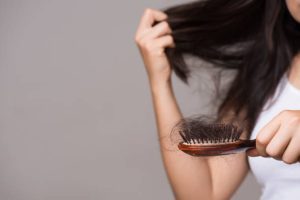Whether it's a bald patch on the head or a receding hairline, hair loss is sometimes the first indication of aging that men notice.
Because it frequently begins early, hair loss can be extremely challenging to manage. In fact, according to a study, 16% of males and females between the ages of 18 and 29 already exhibit some indicators of moderate or significant hair loss.
Losing your hair is challenging at any age, but it can be incredibly upsetting in your teen years, 20s, or 30s. However, more alternatives are available to you than you might realize regarding how you respond.
If you're noticing a few extra hairs on your pillow or at the bottom of the shower drain every morning, keep reading as we've gone into more detail about each of these recommendations to help you maintain your confidence.
The most common types of hair loss you can suffer in your 20s, 30s, 40s, or later in life are also covered in our explanation of why hair loss occurs.

Let's start by knowing what causes hair loss:
When it comes to hair loss, finding out what's causing it and whether it will be permanent is the first step.
Men and women might have a wide variety of hair loss conditions, even though we frequently assume that all hair loss is the same. Every sort of hair loss can result in a different set of symptoms and may call for a different, more specialized treatment method.
Below, you may find a list of the most common types of hair loss, along with the precise causes of each.
Androgenetic Alopecia- Male pattern baldness, also known as androgenetic alopecia, is the most common kind of hair loss in men.
In this hair loss, the thinning typically begins at your hairline or crown and gradually worsens until it is more prominent. With dense hair on the sides of your head and little to no hair on top over time, you get the traditional “back and sides” hair pattern.
A hormone called dihydrotestosterone, or DHT, and a mix of hereditary and environmental factors are the main contributors to male pattern baldness. DHT has the capacity to attach to receptors in the scalp over time, shrinking hair follicles. Hair loss becomes apparent as the hair follicles shrink and finally stop growing new hair. Male pattern baldness causes permanent hair loss, so it's critical to identify it early and begin treatment as soon as possible.
Telogen Effluvium- Temporary hair loss occurs in the form of telogen effluvium. It is a reactive process brought on by outside stressors like infections, nutritional shortages, surgery, illnesses that make you feverish, and abrupt changes in your hormone levels.
Telogen effluvium doesn't destroy your hair follicles as male pattern baldness does. Instead, telogen effluvium causes a sudden transition of your hairs from the anagen, or growth, phase of the hair growth cycle into the telogen, or resting, phase, which results in hair loss.
The typical result of telogen effluvium is diffuse thinning that affects your entire scalp instead of a receding hairline or bald patch.
Telogen effluvium causes transient hair loss. It may take months for your hair to regrow normally, even if the underlying reason of your hair loss has been addressed.
Anagen Effluvium- Another type of transient hair shedding is anagen effluvium. In contrast to telogen effluvium, anagen effluvium is invariably brought on by drugs, especially cancer treatments like chemotherapy and radiation therapy.
Due to this relationship, anagen effluvium is occasionally referred to as chemotherapy-induced hair loss.
Anagen effluvium develops when your hair's development cycle is disrupted, like telogen effluvium. In this situation, the side effects of the medicine impact the growth of the hair shaft, leading to early shedding of your scalp, face, body, and pubic hair.
Hair loss from anagen effluvium typically happens swiftly. You might start noticing shedding in the first 14 days after starting a medicine that can lead to this kind of hair loss.
Anagen effluvium, like other hair-loss processes, is temporary. Your hair will gradually regrow to its usual state after you are no longer required to take medication.
Other Types of Hair Loss
You can lose hair due to various diseases, health problems, and behaviors, including scalp infections like tinea capitis and anxiety-related disorders like trichotillomania, a type of persistent hair pulling.
Now that you know what causes hair loss in both men and women. Here are some tips to keep your confidence when you experience hair loss.
Tips for Keeping Your Confidence With Hair Loss
The good news is that while hair loss can significantly lower your confidence, it doesn't have to have a long-term impact on your thoughts, feelings, or actions.
Your potential to feel confident, find love, or simply enjoy life, in general, is not destroyed by hair loss. Just consider the large number of famous men who have gone bald, including businessmen and entertainers. Do you believe they are concerned about it?

The second good news is that hair loss doesn't have to be permanent if you act quickly. You can typically prevent more hair loss and even regrow some of your lost hair with the appropriate strategy, as we've discussed lower down the page.
Even though you may not have any control over how quickly or how much hair you lose, you do have control over how it affects you.
Here are some effective methods for addressing hair loss:
Adjust your perspective on things- You've probably heard the phrase “you are your own worst critic,” and it couldn't be more accurate. You are more critical of yourself than anybody else. Furthermore, this implies that you probably have a more negative perception of your hair loss than most people.
You might find that your hair loss is a change you don't want to see every time you look in the mirror. Others may view it as merely a physical characteristic that contributes to your distinctive appearance.
Be realistic about it- Hair loss isn't harmful; it doesn't endanger your life or negatively affect your health, even though it may be uncomfortable.
As a result, being realistic about hair loss is one of the best ways to handle it. Accept the situation, seek to make it work, and turn it into a strength rather than a flaw you are self-conscious about.
Remember that hair loss is a genetic and hormonal disorder rather than a severe illness or a handicap. Add it to your persona. The psychological adjustment to hair loss might be challenging, but only to the extent that you let it be.
Choose a Look That Suits You: Contrary to popular opinion, getting a trendy haircut doesn't imply you can't wear it if you have a receding hairline or some thinning on top of your head.
The trick is to pick a hairstyle that complements your hair. Choose a thinning hairstyle like a buzz cut, quiff, or skin fade rather than something that calls for a low hairline or a lot of thickness.
Try growing out the hair at the front of your head and combing it backward if your hairline is receding, or cut your hair short on the sides to hide your hairline. Try parting your hair on the side of your head where the bald spot is beginning to appear.
It's essential to select a style that complements your current hair, not the hair you wish you had. With the correct mindset, you can make your hair a strength rather than a weakness. Choose something that suits you and wear it with confidence.
If all else fails, shaving off your hair is always an option. In addition to saving a modest fortune in future hairstyle costs, the “nuclear option” for baldness frequently looks rather excellent.
Be Careful When Caring For Your Hair: It's crucial to be cautious when styling and caring for your hair if you're losing hair due to a nutritional deficiency or the side effects of cancer therapy.
Avoiding hair dryers (let your hair dry naturally instead) and using gentle hair products to wash or style your hair are a few easy ways to avoid stressing your hair follicles.
Try using a satin pillowcase or a hair net if you experience nighttime hair loss to lessen the stress on your hair roots.
Although these methods won't always stop hair loss, they can prevent you from unintentionally pulling off weak hair.
Think About Hair Transplant Surgery: If your hair loss is more prominent or you desire quick results, you might want to consider hair transplant surgery.
In this cosmetic surgery, hair follicles from the sides and back of your head are removed and used to rebuild your hairline or crown. This kind of surgery, when carried out by a skilled hair transplant surgeon, can result in natural-looking, attractive outcomes.
The major drawback of hair transplantation is that it is expensive and provides no assurance against further hair loss. Additionally, you'll still need some hair; if you've lost all of it, this may not be the best option.
Conclusion- How to deal with hair loss:
Although losing your hair is something you cannot control, you can decide how to react. One choice is to remain in denial and let your baldness undermine your self-esteem, degrade your standard of living, and prevent you from experiencing happiness and fulfillment.
The second choice is to accept hair loss as a natural part of life and, if required, begin taking steps to control it.
For many people, losing their hair is a stressful experience. It can cause anxiety and depression, making it difficult to feel comfortable in one's skin. With this article, you can learn what you can do to help with these issues while improving your overall quality of life.
